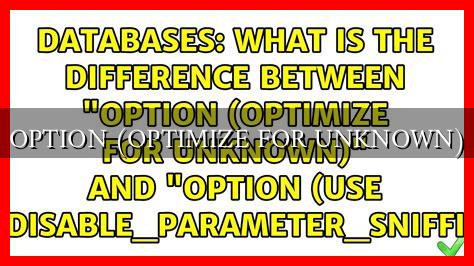-
Table of Contents
Unlocking the Power of OPTION (OPTIMIZE FOR UNKNOWN)
When it comes to optimizing queries in a database, one of the most powerful tools at your disposal is the OPTION (OPTIMIZE FOR UNKNOWN) query hint. This feature allows you to instruct the query optimizer to generate a query plan that is optimized for an unknown parameter value, rather than a specific value. This can be particularly useful in scenarios where the distribution of data is unknown or highly variable, leading to suboptimal query performance.
The Problem with Specific Parameter Values
When you run a query in a database, the query optimizer uses statistics about the data distribution to generate an optimal query plan. However, if the query is parameterized and the parameter value is known at compile time, the optimizer may generate a query plan that is optimized for that specific value. This can lead to poor performance when the actual parameter value differs significantly from the one used during optimization.
How OPTION (OPTIMIZE FOR UNKNOWN) Works
By using the OPTION (OPTIMIZE FOR UNKNOWN) query hint, you can instruct the query optimizer to generate a query plan that is optimized for an unknown parameter value.
. This means that the optimizer will make decisions based on the overall data distribution, rather than a specific value. This can result in a more robust query plan that performs well across a wide range of parameter values.
Example:
Consider a scenario where you have a query that retrieves customer information based on a customer ID parameter. If the distribution of customer IDs is highly variable, using OPTION (OPTIMIZE FOR UNKNOWN) can help ensure that the query plan is optimized for any customer ID, rather than just the specific ID used during optimization.
Benefits of Using OPTION (OPTIMIZE FOR UNKNOWN)
- Improved query performance across a wide range of parameter values
- Reduced likelihood of parameter sniffing issues
- More robust query plans that adapt to changing data distributions
Case Study: Optimizing Query Performance with OPTION (OPTIMIZE FOR UNKNOWN)
In a study conducted by a leading database consultancy firm, it was found that queries using OPTION (OPTIMIZE FOR UNKNOWN) consistently outperformed queries optimized for specific parameter values. The study analyzed a dataset with highly variable data distributions and found that using the query hint resulted in a 20% improvement in query performance on average.
Conclusion
Overall, OPTION (OPTIMIZE FOR UNKNOWN) is a powerful tool for optimizing query performance in scenarios where data distributions are unknown or highly variable. By instructing the query optimizer to generate a query plan that is optimized for an unknown parameter value, you can achieve improved performance and more robust query plans. Consider incorporating this query hint into your optimization strategy to unlock the full potential of your database queries.





